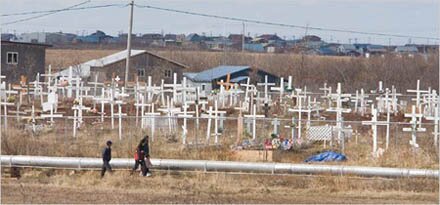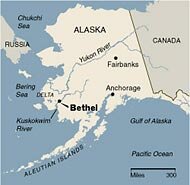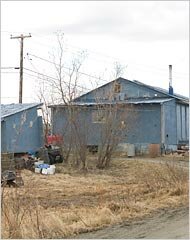|
Bethel Journal
By William Yardley
Published: May 14, 2007
 |
|
Charles Mason for The New York Times
|
|
The main cemetery in Bethel. The suicide rate among Native Alaskans was three times that of nonnative residents from 2003 to 2006.
|
BETHEL, Alaska, May 10 - The older brother hanged himself. The younger one used a gun. They died 38 days apart.
| |

|
| |
The New York Times
|
| |
Bethel, population 6,000, is a hub for scores of villages smaller and more remote.
|
They had lived in this muddy town of 6,000 people, a hub at the center of scores of much smaller and more remote native villages in the Yukon-Kuskokwim Delta of southwest Alaska. Their parents taught them to hunt for geese and seals and to fish for pike and herring and salmon. They taught them to speak their native Yupik and to cut wood for steam baths each night, even as one son played electric guitar and the family surfed the Internet.
"Sit," said Evon Waska, the father, directing two visitors to a freshly finished wooden bench in his living room. Mr. Waska had placed it like a pew before a makeshift memorial of cards and photographs of the dead. "Sit with us."
"When I was heartbroken," he said, "I put my sorrow into making that bench."
In grieving for the older son, William George Kinzy, 34, who died on March 8, and his half-brother, Evon David Waska Jr., 20, who shot himself on April 15, Mr. Waska and his wife, Dora, are suffering a cruel concentration of the kind of loss that so many others in communities like theirs confront.
| |

|
| |
Charles Mason for The New York Times
|
| |
Memorial programs on a bench built for two brothers who killed themselves this year.
|
"Rural Alaska has some of the highest rates in the world for suicide," said Ron Perkins, who came to Alaska three decades ago to work for the federal government's health program for Native Alaskans and now is executive director of the Alaska Injury Prevention Center, a nonprofit organization. "I remember talking once to an elder in a village outside Kotzebue. He said, 'I was 20 years old before I first heard of a suicide, and then it was a white man in Kotzebue.' Now, if a native kid is 10 and hasn't heard of a suicide, it's rare."
The suicide rate among Native Alaskans was three times that of nonnative Alaska residents and five times the national rate from 2003 to 2006, according to a study Mr. Perkins helped conduct.
Contrasts are also striking in the ages of those committing suicide. Nationwide, people 80 and over and those in their 40s are most likely to kill themselves. Among Alaska natives, the 20-to-29 age group had the most suicides, 39 percent of the total, while that age group ranked seventh nationwide.
Natives ages 10 to 19 make up just 20 percent of the state population in that age group, but accounted for 61 percent of its suicides.
The suicide rates for natives declined somewhat in 2005 and 2006, but Mr. Perkins said it was too soon to know whether that reflected a pattern. Roughly 80 percent of all Alaska suicide victims are male.
| |

|
| |
Charles Mason for The New York Times
|
| |
The Waska home. The family was preparing to hold a memorial feast for one son when a second, younger son killed himself with a gun.
|
Suicide among natives is commonly linked with depression and mental illness, which often goes untreated in rural areas, as well as with alcoholism and cultural and economic stress. Many native families are reluctant to discuss suicide, adding to the challenge, Mr. Perkins said.
Native death rates over all are about 50 percent higher than for nonnatives, according to data compiled by the Institute of Social and Economic Research at the University of Alaska Anchorage. Natives are increasingly moving to urban areas from rural villages and native families are increasingly led by a single parent. Women are more likely than men to move to cities to find work.
"They've lost their culture, they don't have a way to support their family, and then what we see is a lot of alcohol and drug use, particularly alcohol," said Diane Casto, the section manager for prevention and early intervention for the state's division of behavioral health. "There's such a feeling of hopelessness, particularly for young men."
Christian missionaries, followed by government bureaucracy and modern technology, have long since transformed villages on the tundra into places where seal meat is hung out to dry in the shadow of steeples, public schools and satellite dishes. Many natives still hunt and fish for staples even as the outside culture promotes materialism. Experts say young people often have frayed connections to the old ways but poor preparation for living in a modern world.
"How do you move out, how do you move on?" said Yvonne Kinegak, an intake supervisor for the Bethel branch of the state's Office of Children's Services. "We see healthier people when they're more connected to their culture."
Bonnie Bradbury, who teaches Sunday school at United Pentecostal Church in Bethel, where her husband is the pastor, said that deaths among natives, many of whom in the delta are Russian Orthodox, are repeatedly memorialized through feasts at various anniversaries. Evon David Waska Jr. killed himself as his family was preparing for a feast on the 40th day after his half-brother died.
"They think, well, if they don't think much of me now, maybe they will when I'm dead," Ms. Bradbury said, echoing a common view.
Mr. Perkins, who conducted the suicide study, acknowledged that perception but said he knew of no way to confirm it. Misperceptions about native suicides are common, he said, including the belief that more people kill themselves during the dark Alaskan winters.
"We found that suicides occurred all during the year," he said, noting that December, one of the darkest months, had one of the lowest suicide rates.
Alcohol or drugs were a factor in nearly three-fourths of the suicides among natives, the same as for nonnatives. And while about two-thirds of all suicides were from gunshot wounds, natives were twice as likely to hang themselves as were nonnatives, even though gun ownership is high among natives.
Mr. Perkins said that efforts were being made to help people maintain their connection to native culture and language, but that some groups less likely to speak their native language, like the Aleuts, had relatively low suicide rates.
"They're past that cultural transition," he said.
|
